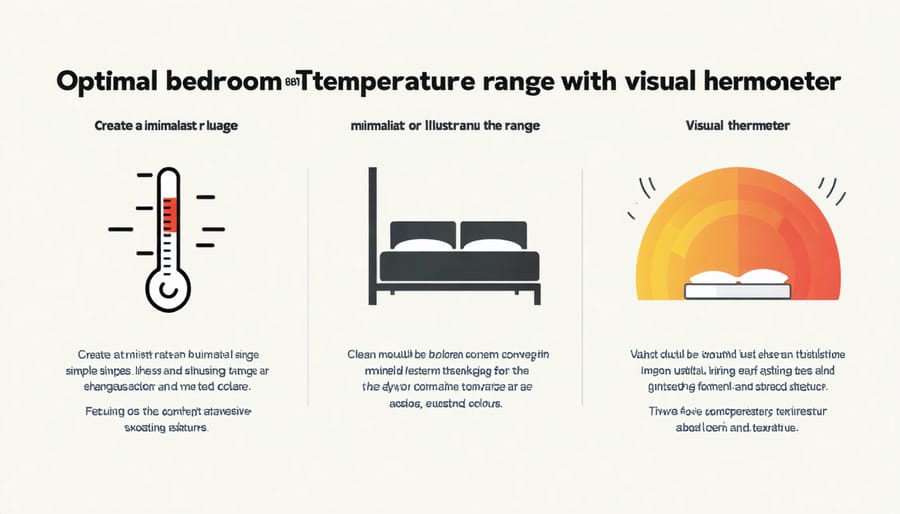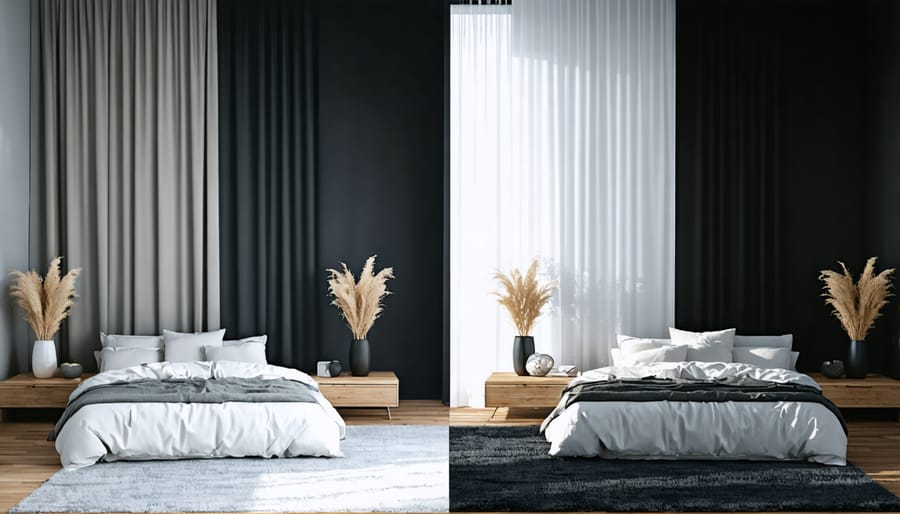Transform your bedroom into a REM sleep sanctuary by maintaining a consistent 65-68°F (18-20°C) temperature, blocking all light sources with blackout curtains, and using a white noise machine set to 60-70 decibels. REM sleep, accounting for 20-25% of your total sleep cycle, requires precise environmental conditions to reach its optimal 90-120 minute duration. Create a sleep-inducing atmosphere by installing a smart thermostat with nighttime temperature scheduling, positioning your bed away from windows and electronic devices, and ensuring proper air circulation with a HEPA air purifier. Studies show that optimizing these bedroom conditions can increase REM sleep duration by up to 25%, leading to enhanced memory consolidation, emotional processing, and cognitive performance the next day. Your body naturally enters REM sleep every 90 minutes – make each cycle count by controlling these environmental factors that directly impact sleep architecture.
The Science Behind Perfect REM Sleep
Understanding Your Sleep Cycles
Your sleep isn’t just one long stretch of unconsciousness – it’s actually a fascinating cycle of different stages that repeat throughout the night. Think of it like waves in the ocean, with each complete cycle lasting about 90 minutes. You start with light sleep, where you’re easily awakened, then move into deeper sleep stages where your body focuses on physical restoration.
But the star of the show is REM (Rapid Eye Movement) sleep, which typically occurs about 4-5 times per night. During REM sleep, your brain becomes incredibly active, processing emotions, consolidating memories, and fostering creativity. It’s like your mind’s maintenance crew, working the night shift to keep everything running smoothly.
Getting enough REM sleep is crucial for your mental well-being. Without it, you might experience difficulty concentrating, mood swings, and reduced problem-solving abilities. The good news is that by understanding these cycles, you can make informed decisions about your sleep schedule and environment to maximize the quality of your rest. Most adults need about 1.5-2 hours of REM sleep per night, which you’ll get naturally if you aim for 7-9 hours of total sleep.

Environmental Impact on Sleep Quality
Your bedroom environment plays a crucial role in achieving quality REM sleep. The ideal sleep sanctuary starts with temperature control – aim to keep your room between 60-67°F (15-19°C), as this range promotes better REM cycles. Too hot or too cold, and your body will struggle to maintain the perfect sleep temperature.
Light exposure significantly impacts your sleep quality. Install blackout curtains or shades to create complete darkness, which helps boost melatonin production. Even small sources of light from electronics can disrupt your REM sleep, so consider using blue light filters or removing devices altogether.
Sound management is equally important. While complete silence works for some, others benefit from white noise to mask disruptive sounds. Consider using a fan or white noise machine to create a consistent sound environment that won’t interrupt your sleep cycles.
Air quality shouldn’t be overlooked. Good ventilation and optimal humidity (between 30-50%) can help you breathe easier during sleep. Try using a humidifier in dry conditions or a dehumidifier in humid environments to maintain the perfect balance for restorative REM sleep.
Creating Your Ideal Sleep Temperature Zone
Perfect Temperature Range
The ideal bedroom temperature for optimal REM sleep falls between 60-67°F (15.5-19.4°C). This range helps your body naturally lower its core temperature, which is essential for initiating and maintaining quality sleep cycles. While this might feel a bit cool at first, it’s the sweet spot for most people.
To achieve and maintain this perfect temperature range, start by setting your thermostat about an hour before bedtime. If you don’t have central air, a programmable fan or window AC unit can help maintain consistent temperatures. During warmer months, try using lightweight, breathable bedding materials like cotton or bamboo, and consider adding a cooling mattress topper if you tend to sleep hot.
For those who find this temperature range too cool, layer your bedding instead of raising the thermostat. Start with a light sheet and add a blanket or duvet that you can easily remove during the night. Wearing light, breathable sleepwear can also help you stay comfortable without compromising the room’s temperature.
Monitor your bedroom temperature using a simple digital thermometer, and pay attention to how different temperatures affect your sleep quality. Keep a sleep journal for a week while experimenting with temperatures within this range to find your personal sweet spot.

Smart Climate Control Solutions
Creating the perfect sleep environment starts with mastering your bedroom’s temperature. Research shows that the ideal sleeping temperature falls between 60-67°F (15-19°C), but maintaining this sweet spot consistently can be challenging. Thankfully, modern climate control solutions make it easier than ever to achieve optimal sleep conditions.
Smart thermostats are your first line of defense against temperature fluctuations. These intelligent devices can automatically adjust your room’s temperature throughout the night, following your natural sleep cycles. Many models can even learn your preferences over time and make automatic adjustments based on your habits.
For more precise control, consider investing in a bed cooling system. These innovative devices use water or air circulation to regulate your mattress temperature, allowing you to fine-tune the surface temperature of your bed. Some advanced systems even offer dual-zone control, perfect for couples with different temperature preferences.
Ceiling fans with smart controls can help circulate air effectively while consuming less energy than air conditioning. Look for models with sleep modes that automatically adjust fan speed throughout the night. Additionally, thermal curtains or cellular shades can help maintain consistent room temperatures by blocking heat in summer and keeping warmth in during winter.
Remember to monitor humidity levels as well. A smart dehumidifier or humidifier can maintain the ideal humidity range of 30-50%, preventing the discomfort of dry air or excess moisture that can disrupt your sleep.
Light Management for Better REM Sleep
Natural vs. Artificial Light Balance
Balancing natural and artificial light throughout the day is crucial for maintaining healthy sleep patterns. Your body’s circadian rhythm responds strongly to natural light benefits, so try to maximize daylight exposure during morning and early afternoon hours. Open your curtains fully when you wake up, and consider positioning your desk or favorite reading spot near a window.
As evening approaches, gradually transition to warmer, dimmer lighting. Modern smart lighting for wellness can automatically adjust color temperature and brightness throughout the day, supporting your natural sleep-wake cycle. Install dimmer switches or use smart bulbs that can shift from energizing cool light during the day to sleep-promoting warm light in the evening.
Two hours before bedtime, reduce exposure to bright artificial light, especially blue light from screens. Use warm-toned lamps or night lights for evening activities, and consider installing blackout curtains to prevent street lights from disrupting your sleep. If you need to get up during the night, use motion-sensor night lights with red wavelengths, which are less likely to interfere with your sleep cycle.

Blackout Solutions That Work
Creating a truly dark sleep environment doesn’t have to be complicated or expensive. For quick and effective solutions, start with blackout curtains that extend beyond your window frame. Look for curtains with a light-blocking rating of 90% or higher, and install them using wrap-around rods to prevent light leakage at the sides.
For maximum darkness, combine curtains with cellular blackout shades mounted inside the window frame. This dual-layer approach catches any persistent light seepage. When installing, use magnetic strips along the edges of your shades to create a complete seal against the window frame.
Don’t forget about those pesky light sources within your bedroom. Cover LED displays on electronics with light-blocking tape or stickers, and consider replacing bright digital clocks with dimmer alternatives. For under-door light, a simple draft stopper works wonders.
For renters or those seeking temporary solutions, removable window film offers an excellent alternative. These films adhere directly to glass using static cling and can be easily removed without damage. Combine with portable blackout blinds for a complete darkness solution that won’t upset your landlord.
Remember to test your room’s darkness during daylight hours – if you can still see your hand in front of your face, there’s room for improvement.
Sound-Optimized Sleeping Space
Noise Reduction Techniques
Creating a peaceful sleep environment starts with effective noise control. Fortunately, there are numerous DIY soundproofing solutions that can significantly reduce unwanted noise in your bedroom.
Start with your windows, as they’re often the biggest culprits for noise infiltration. Installing thick, sound-dampening curtains or cellular shades can make a noticeable difference. Weather stripping around window frames helps seal any gaps where sound might sneak in.
For walls, consider adding mass-loaded vinyl or acoustic panels. These can be decorated to match your room’s aesthetic while effectively absorbing sound waves. Door sweeps and draft stoppers not only prevent cold air but also block noise from traveling under doors.
Professional solutions include double-pane window installation, wall insulation upgrades, and floating floor systems. While these options require more investment, they provide long-lasting noise reduction benefits.
Quick fixes like white noise machines, air purifiers, or even simple foam earplugs can help mask disruptive sounds. Position your bed away from shared walls and external noise sources when possible. Remember, even small changes can lead to significant improvements in your sleep environment’s acoustics.
Beneficial Sound Solutions
Sound can make or break your sleep quality, but you can harness its power to enhance your REM sleep naturally. White noise machines and nature sounds work by creating a consistent audio backdrop that masks disruptive noises and helps your brain maintain deeper sleep stages.
For optimal results, position your sound machine about 6-8 feet from your bed, keeping the volume between 60-70 decibels – about as loud as a normal conversation. White noise isn’t your only option; pink noise, which emphasizes lower frequencies, has been shown to improve deep sleep quality. Nature sounds like rainfall, ocean waves, or forest ambiance can be equally effective, especially if you find them more relaxing than synthetic sounds.
Consider using a smart speaker or dedicated sleep sound device with a timer function. This allows you to gradually reduce the volume as you fall deeper into sleep, preventing the sound from becoming disruptive later in the night. If you share your bedroom, make sure your sound solution works for both sleepers – some devices offer dual-zone audio or wireless earbuds for personalized listening.
Remember to experiment with different sounds and volumes to find what works best for your sleep environment. The right audio environment can significantly improve your REM sleep quality while creating a peaceful bedroom atmosphere.
Air Quality and Circulation
Clean Air Strategies
Clean, fresh air is essential for achieving optimal REM sleep, and there are several effective ways to improve indoor air quality in your bedroom. Start by establishing a regular ventilation routine – open your windows for at least 15 minutes each morning to allow fresh air circulation and remove accumulated pollutants from the night.
Consider investing in a high-quality air purifier with a HEPA filter, which can remove up to 99.97% of airborne particles, including dust, pollen, and pet dander. Place it about 3-6 feet from your bed for maximum effectiveness. Remember to change or clean the filters according to the manufacturer’s recommendations.
Maintaining optimal humidity levels (between 30-50%) is crucial for both air quality and sleep comfort. Use a humidity monitor and adjust accordingly with a humidifier or dehumidifier. During drier months, a small bedroom humidifier can prevent throat irritation and dry sinuses that might disrupt your sleep.
Keep your bedroom clean to minimize dust and allergens. Vacuum regularly, including under the bed, and wash bedding weekly in hot water. Consider using allergen-proof mattress and pillow covers to reduce dust mites. Indoor plants like snake plants or spider plants can act as natural air purifiers, but limit them to 1-2 per room to avoid excess humidity.
Avoid using harsh cleaning products or air fresheners before bedtime, as these can release volatile organic compounds (VOCs) that may affect your breathing and sleep quality. Instead, opt for natural cleaning solutions and essential oils if you want to add a pleasant scent to your space.
Creating the perfect sleep environment for optimal REM sleep doesn’t have to be complicated or expensive. By making thoughtful adjustments to your bedroom’s temperature, lighting, sound levels, and air quality, you can significantly improve your chances of achieving restorative sleep each night. Remember to maintain a cool room temperature between 60-67°F, eliminate light pollution with proper window treatments, minimize noise disruptions, and ensure good air circulation.
Start with small changes and observe how they affect your sleep quality. You might begin by installing blackout curtains or trying a white noise machine. As you implement these improvements, pay attention to how your sleep patterns change and adjust accordingly. The key is consistency – maintain your optimized sleep environment every night to help your body establish healthy sleep rhythms.
Don’t forget that your sleep environment is personal to you. What works for others might need tweaking to suit your preferences. Be patient with the process, and remember that investing time and effort into creating your ideal sleep sanctuary will pay dividends in improved health, energy, and overall well-being.
